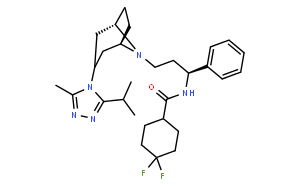| HeLa-P4 cells |
Function assay |
|
20 days |
|
Antagonist activity at CCR5 receptor expressed in HeLa-P4 cells co-expressing CD4 assessed as inhibition of infusion to HIV gp120 expressed in CHO-tat10 cells after 20 hrs by cell-cell fusion assay, IC50=0.2 nM |
21128663 |
| rhesus monkey Chem-1 cell |
Function assay |
|
120 mins |
|
Displacement of [125I]-MIP-1alpha from CCR5 in rhesus monkey Chem-1 cell membranes after 120 mins by liquid scintillation counting analysis, Ki=0.24 nM |
23682308 |
| human TZM-bl cells |
Function assay |
|
48 h |
|
Antagonist activity against CCR5 receptor in human TZM-bl cells assessed as inhibition of HIV-1 MGC26-induced cell-cell fusion between viral envelope protein expressing human HEK293 cells to TZM-bl cells after 48 hrs by luciferase reporter gene assay, IC50=0.37 nM |
24563723 |
| CHO cells |
Function assay |
|
2 h |
|
Displacement of [128I]RANTES from human CCR5 receptor coexpressed with Galphai6 in CHO cells after 2 hrs by scintillation counting, IC50=1.4 nM |
20137937 |
| HOS cells |
Function assay |
|
|
|
Antiviral activity against HIV1 Ba-L infected in HOS cells assessed as inhibition of viral infection, IC50=2 nM |
19664920 |
| HEK293 cells |
Function assay |
|
|
|
Inhibition of human MATE1-mediated ASP+ uptake expressed in HEK293 cells after 1.5 mins by fluorescence assay, IC50=17.3 Îm |
23241029 |
| human astrocytes |
Function assay |
100 nM |
30 to 60 mins |
|
Binding affinity to CCR5/MOR in human astrocytes assessed as inhibition of R5 HIV-1 SF162 infection by measuring Tat protein expression at 100 nM preincubated for 30 to 60 mins followed by viral infection measured after 18 hrs by luciferase reporter gene assay |
23682308 |

 COA
COA MSDS
MSDS HPLC
HPLC NMR
NMR